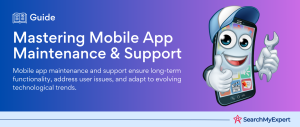In today’s digital world, businesses want to reach everyone, everywhere. One way they do this is through mobile apps that can speak different languages. But, Development of mobile app that understands many languages isn’t easy. Let’s see why these apps are needed and the challenges in making them.
Why Do We Need Multilingual Apps?
Businesses now operate globally, and to communicate well, they need to speak in many languages. A lot of people don’t speak English as their first language. So, for a business app to be successful globally, it must speak more than one language.
What’s a Multilingual App?
Simply, it’s an app that can operate in multiple languages. This helps businesses reach more people and offer a personal touch, which can lead to more sales and happy customers.
Main Challenges in Making Multilingual Apps
Making an app that speaks different languages is tricky. Here’s why:
1. Translating Isn’t Just About Words
Language is deep. It’s not just about changing words. It involves feelings, culture, and more.
- Computer vs Human Translators: Computers can translate fast but might miss the feeling or depth. People can capture the depth, but they’re slower and can be expensive.
2. Dates & Times Change
Different places have different times and ways of showing dates. An app needs to know and show this right for every user.
3. Design Changes with Language
When you change the language, the look of the app can change too. Some languages need more space, and this can affect how the app feels and works.
Things to Keep in Mind When Making Multilingual Apps
- Translate Everything Together: It’s good if the main app and its help section are translated at the same time. This makes the app feel consistent.
- Give Translators Guidance: Adding notes in the app can help translators know what you want, making the final product better.
- Think Local: Remember to adjust things like symbols and images because they can mean different things in different places.
- Be Flexible: Dates, times, and money can look different everywhere. The app should be ready to show these in many ways.
- Test Well: Before launching, check the app in all languages to fix any mistakes.
- Use Translation Tools: There are systems to help with translating. They can make fixing errors faster by letting translators and app makers work together.
The Benefits of Going Multilingual
While the journey to develop a multilingual app might seem daunting, the benefits are immense.
1. Wider Reach
A single-language app restricts your audience. With every new language added, you unlock a potential market of millions of users. From Spanish speakers in Latin America to Mandarin speakers in China, your app can resonate with diverse user groups globally.
2. Better Engagement
By communicating in the user’s native language, you foster trust. Trust leads to better engagement, as users feel the app is tailored for them, leading to increased usage and brand loyalty.
3. Higher Revenue Potential
More users and better engagement naturally lead to higher revenue opportunities. Whether it’s through in-app purchases, ads, or subscriptions, a multilingual approach can significantly boost the bottom line.
4. Competitive Advantage
While many apps might offer similar features, the one that speaks the user’s language often stands out. This unique selling point can be the difference between an app being downloaded or ignored.
5. Cultural Inclusivity
By embracing multiple languages, businesses also show respect for diverse cultures. This inclusivity can enhance the brand image, portraying the company as global-minded and culturally sensitive.
Next Steps in Your Multilingual App Journey
- Feedback is Gold: Once your multilingual app is live, gather feedback from users in different regions. Their insights can guide improvements and refinements.
- Continuous Updates: Languages evolve. Stay updated with linguistic changes and cultural shifts to ensure your app remains relevant.
- Collaborate with Local Experts: Partnering with native language experts can ensure the app’s content remains authentic and culturally appropriate.
- Promote in Local Markets: Launch localized marketing campaigns to promote your app in target regions, maximizing visibility and downloads.
The Future of Multilingual Apps
The digital landscape is evolving rapidly, and with it, the realm of multilingual apps is also undergoing significant transformations.
1. Emergence of Real-time Translation
With advancements in artificial intelligence and machine learning, the future may see apps equipped with real-time translation capabilities. This means users can communicate seamlessly, without language barriers, enhancing global interactions.
2. Voice-activated Multilingual Interfaces
Voice technology, such as Siri, Alexa, and Google Assistant, is becoming a staple in our digital experiences. Soon, multilingual apps might integrate voice-activated interfaces in multiple languages, catering to users who prefer voice commands over traditional touch interfaces.
3. Cultural Personalization
Beyond just language, apps may evolve to offer cultural personalization. For instance, an app might adjust its interface during a local festival or display greetings based on regional holidays, deepening the personal connection with users.
4. Expansion to Lesser-Known Languages
While many apps currently cater to widely spoken languages, there’s an increasing emphasis on including regional and lesser-known languages, ensuring even the most niche audiences aren’t left out.
5. Integrated Multilingual Communities
Future apps may foster communities where users from different linguistic backgrounds can collaborate, share, and learn from each other, thereby creating a melting pot of diverse cultures and ideas.
Leveraging Technology for Language
- Augmented Reality (AR) Translations: Imagine pointing your phone at a sign in a foreign language, and your app instantly overlays a translation. AR can make this a reality, enhancing travel and global business communications.
- Language Learning Integration: Multilingual apps may soon integrate language-learning modules, allowing users not only to use the app in their chosen language but also to learn new languages within the app environment.
- Adaptive Algorithms: Using AI, apps might soon predict the user’s language preference based on their location, usage patterns, and other behavioral metrics, making language selection effortless.
Here is the diagram illustrating the
Localization Process for Design Adaptation to Target Languages

The Broader Impact of Multilingual Apps
As multilingual apps continue to gain traction, they are also bringing about profound societal and cultural shifts. Here’s a glimpse into the wider ramifications and benefits they offer.
1. Education and Learning
Multilingual apps are becoming a treasure trove for learners. They are not just aiding in language acquisition but also facilitating access to content in diverse subjects, from science to humanities, in multiple languages. This democratises knowledge, ensuring that information isn’t bound by linguistic constraints.
2. Promotion of Indigenous Languages
Many indigenous languages are on the brink of extinction. Multilingual apps that offer content in these languages can play a vital role in their preservation, ensuring that rich linguistic legacies are passed down to future generations.
3. Business Opportunities
For businesses, multilingual apps open the doors to untapped markets. They allow local entrepreneurs to connect with global audiences and vice versa, fostering international collaborations and partnerships.
4. Enhanced Social Cohesion
By breaking down language barriers, these apps are fostering greater understanding among diverse cultural groups. They help dispel myths and stereotypes, enabling more harmonious interactions and relationships across different communities.
5. Health and Wellbeing
There’s a growing trend of health and wellness apps becoming multilingual. This ensures that vital health information and resources are accessible to everyone, regardless of their linguistic background, contributing to global public health and safety.
The Road Ahead: Innovations on the Horizon
- Interactive Language Experiences: The future may see the rise of AR and VR in multilingual apps, where users can immerse themselves in virtual linguistic environments for a richer understanding of languages and cultures.
- Cross-lingual Chatbots: As chatbots become commonplace in customer service, there will be a surge in bots capable of interacting in multiple languages, offering instant support to users globally.
- Linguistic AI Assistants: Beyond mere translation, AI assistants might provide cultural context, idiomatic expressions, and etiquette guidelines for various languages, enhancing the depth of cross-cultural interactions.
- Collaborative Language Platforms: Future multilingual apps might allow users to collaboratively contribute to translations, similar to a wiki model, ensuring constant linguistic updates and refinements.
Conclusion
The journey of multilingual apps is just beginning. As they evolve, they will redefine how we interact, learn, and do business in a globalized world. Their potential impact extends far beyond mere convenience, offering a promise of a world united by language, understanding, and shared experiences. For developers, businesses, and end-users alike, this is an exciting era, full of promise and potential. Embracing the multilingual wave will undoubtedly pave the way for a more interconnected and harmonious global community.
Unlock the gateway to premium App Development Companies right now!
Further Reading
- Integrating Payment Gateways In Mobile Apps
- Mastering Messaging App Development
- Geolocation App Development
- In-App Purchases
- Push Notifications
- User Authentication
- Social Media Integration App Development
- AR/VR App Development
- Offline Mobile App Development
Table of Contents
Toggle






